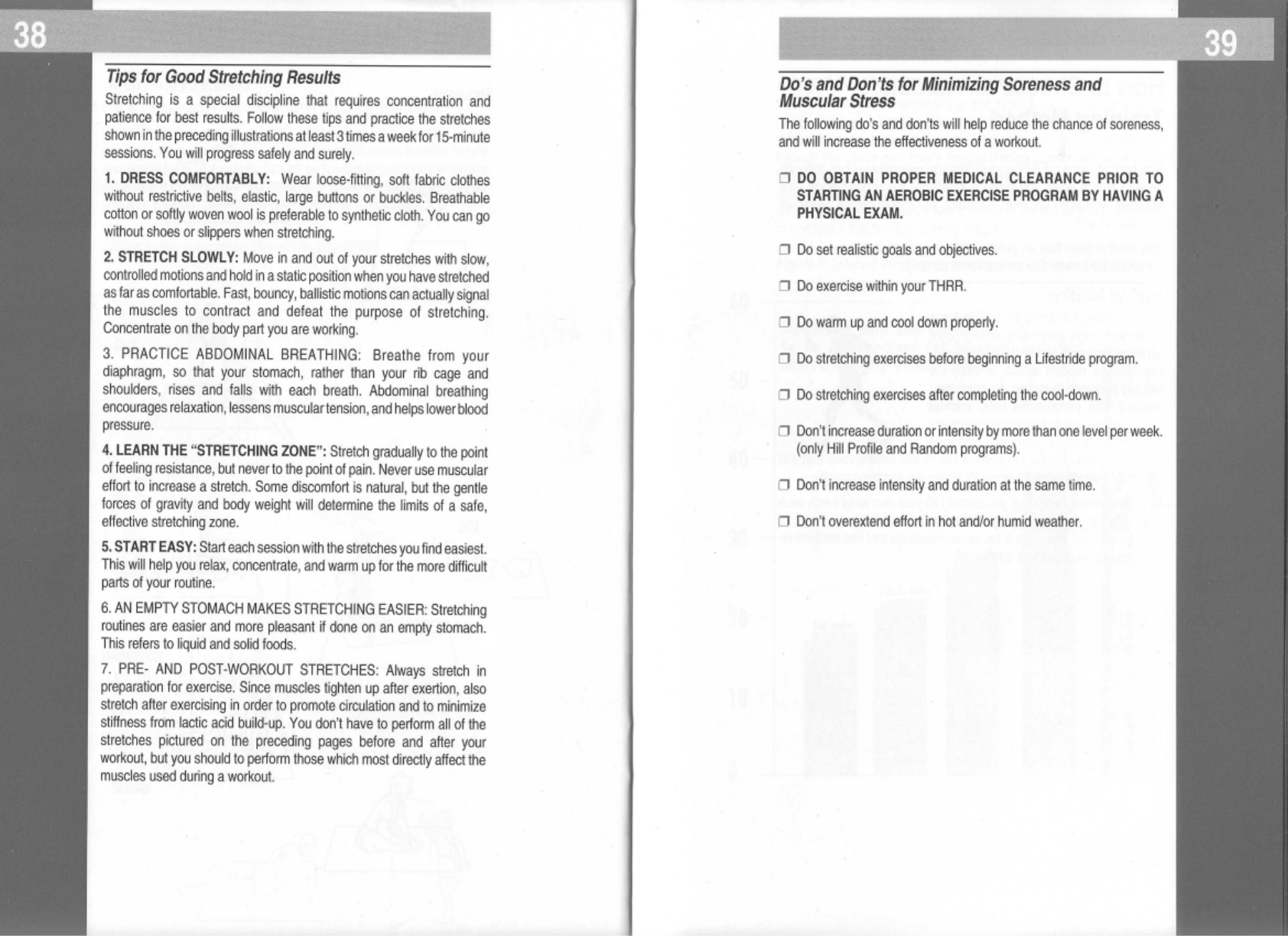
Tips for Good Stretching Results
Stretching is a special
discipline that requires concentration and
patience for
best results.
Follow
these
tips and practice
the stretches
shown inthe
preceding illustrations
at least 3timesa week
for 15-minute
sessions.
You will
progress safely
and surely.
1. DRESS COMFORTABLY:
Wear
loose-fitting, soft fabric
clothes
without
restrictive belts, elastic, large buttons
or
buckles. Breathable
cotton or softly
woven
wool is preferable to synthetic cloth. You can go
without
shoes
or slippers
when stretching.
2. STRETCH
SLOWLY: Move in and out of your
stretches with slow,
controlled motions and hold in a static position
when
you have stretched
as far as comfortable. Fast, bouncy, ballistic motions
can
actually
signal
the
muscles to contract and defeat the purpose of stretching.
Concentrate
on the body part you are
working.
3. PRACTICE
ABDOMINAL
BREATHING: Breathe
from your
diaphragm,
so that
your stomach, rather than your rib
cage
and
shoulders,
rises
and falls with
each
breath. Abdominal breathing
encourages relaxation,
lessens
muscular tension, and helps lower blood
pressure.
4. LEARN THE "STRETCHING ZONE": Stretch
gradually to the point
of feeling resistance, but
never
to the point of pain.
Never
use muscular
effort
to increase a stretch. Some
discomfort
is
natural, but the gentle
forces of gravity and body weight will
determine
the limits of a safe,
effective stretching
zone.
5. START EASY: Start each session
with
the stretches
you find
easiest.
This will help you relax,
concentrate,
and warm up for the more difficult
parts of your routine.
Do's and Don'ts for Minimizing Soreness and
Muscular Stress
The following do's and don'ts will help reduce
the chance
of soreness,
and will increase the effectiveness of a workout.
o DO OBTAIN
PROPER
MEDICAL CLEARANCE PRIOR TO
STARTING AN AEROBIC EXERCISE PROGRAM
BY
HAVING
A
PHYSICAL EXAM.
o Do set realistic goals and objectives.
o Do
exercise
within your THRR.
o Do warm up and
cool
down properly.
o Do
stretching exercises before beginning a Lifestride
program.
o Do stretching exercises after completing the cool-down.
o Don't increase
duration or intensity
by more than one level per week.
(only
Hill Profile and Random
programs).
o Don't increase intensity
and duration
at the same time.
o Don't overextend effort in hot and/or
humid
weather.
6. AN EMPTY STOMACH MAKES STRETCHING EASIER: Stretching
routines
are easier and more pleasant
if
done
on an empty
stomach.
This
refers to liquid and solid foods.
7. PRE- AND POST-WORKOUT STRETCHES: Always stretch in
preparation
for
exercise. Since muscles tighten
up after exertion,
also
stretch
after
exercising in order to promote circulation
and to minimize
stiffness from lactic acid build-up.
You don't have
to perform
all of the
stretches
pictured
on the preceding pages before and after your
workout, but you should to perform those which most directly affect the
muscles used during a workout.


















